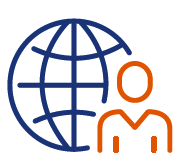Language and internationalisation principles of the University of Tartu
International and high-level academic staff. |
Motivated students with a diverse learning experience. |
Cooperation with strategic partners. |
|
Image

|
Image

|
Image

|
Starting points for language use and internationalisation
- The University of Tartu (‘university’) is an international research university that combines different fields of research.
- As Estonia’s national university, it preserves and develops the Estonian language, Estonian taught education, culture and heritage.
- The university’s students and staff form an able and motivated international community whose teaching, research and development activities are at an internationally excellent level. The university expects its staff to actively gain international experiences.
- The university values a diverse linguistic and cultural space and promotes equal treatment.
- The university’s strategic partners are the networks of recognised research universities mostly from Europe and high-level research universities in Asia and North-America, the cooperation with which is based on top-level competence and mutual research contacts.
- To achieve climate neutrality, the university uses resource-efficient means for internationalisation.
Guiding principles of language use and internationalisation
7. The university provides Estonian-taught higher education on all three levels. When the university opens non-Estonian curricula in its fields of responsibility, it also offers Estoniantaught curricula in these fields at least on the first two levels of higher education.
8. The university offers English-taught curricula in specialisations that are based on the university’s strong research fields, the graduates of which are needed in the Estonian labour market and/or the study cost of which the students are willing to compensate by themselves. The university offers tuition-waiver student places only to the best students.
9. If students admitted to an Estonian-taught curriculum do not speak Estonian or their level of Estonian is not sufficient for starting studies in Estonian, the university gives them the opportunity to learn Estonian. To start studies in an English-taught curriculum, the student’s level of English must be at least B2.
10. To all students of non-Estonian curricula who do not speak Estonian, the university offers Estonian language and culture courses in the volume of at least 6 ECTS in case of two-year curricula.
11. Graduates of Estonian-taught curricula must be able to express themselves in their specialisation at the advanced level in Estonian and at least one foreign language. 12. The university offers students the opportunities to learn other languages apart from English, one aim of which is to allow them to continue their studies and develop themselves in other countries.
13. The Faculty of Arts and Humanities organises the teaching of languages and cultures. All faculties organise the teaching of language for special purposes.
14. The central services related to the organisation of studies and counselling are offered in Estonian or English.
15. The university values the compilation of teaching materials, including digital materials and online lectures, in plain Estonian, English or another language.
16. In the professional review of academic staff, the university aims to place more emphasis on the writing of high-quality university textbooks in Estonian and on the high-quality translation of foreign-language textbooks into Estonian.
17. The university motivates all its doctoral students to achieve the advanced level in Estonian, to ensure a new generation of academic staff as one reason.
18. Doctoral students and their supervisors make sure that the doctoral dissertations in Estonian have summaries in plain English or another foreign language and the non-Estonian doctoral dissertations have summaries in plain Estonian.
19. To foster learning mobility, one part of the curricula of the first and second level is the mobility window1 , indicating which part of the curriculum is advisable to be completed at a foreign university.
20. To diversify learning opportunities and achieve climate neutrality, the university takes virtual mobility2 into account towards the completion of the curriculum.
21. The university opens international joint curricula only with strong academic partners after evaluating the sustainability and economic viability of the curriculum.
22. The university aims to admit the best students from around the world, planning its marketing activities in the target markets chosen in cooperation with the state.
23. In its marketing activities, the university pays attention to Estonians living abroad and students learning Estonian in foreign universities.
24. To promote the university and Estonia as an attractive learning environment, the university centrally coordinates marketing activities and the preparation of recruitment plans and sets the corresponding priorities. In the development of international summer university programmes, also the consistency with non-Estonian degree-study curricula is considered.
25. Researchers of the university actively participate in international cooperation on the creation of new knowledge and proposing solutions to societal issues.
26. The university encourages researchers to publish their research findings in different languages in high-level scientific journals.
27. The university aims to recruit the best academic staff members from across the world.
28. The university fosters researcher mobility.
29. The university develops Estonian terminology sources, coordinates the work of specialist terminology networks, fosters the work of faculty and specialist terminology committees and promotes terminology work in general.
30. To preserve and develop the Estonian language, the university fosters speech recognition, machine translation and other technological solutions.
31. When creating and developing terms and updating and harmonising term bases and databases, academic staff members and students of the university cooperate within the university and with other universities and research institutions in Estonia and abroad.
32. In the recruitment and professional review of academic staff members, the university aims to place more emphasis on the creation of original and translated specialised texts in Estonian.
33. The university cooperates with strong research universities and reputed networks, international research institutions and partners from the public and private sector.
34. The university encourages its academic staff members to initiate cooperation between units with international partners and also offers support for preparing cooperation project applications.
35. The university concludes university-wide partnership agreements if at least two faculties are interested in that cooperation. The faculty’s partnership agreement is based on the wish or one or several units of the faculty to cooperate with a foreign university.
36. The global mobility cooperation agreements of the Erasmus+ programme are concluded centrally based on the proposals of the faculties and European mobility cooperation agreements are concluded at the faculty or its unit.
37. The university applies its knowledge and experiences to improve the higher education and research organisation in the regions of Estonian development cooperation, cooperating with the state of Estonia and applying for support from the European Union and other financing programmes.
38. The working language of the university is Estonian; if necessary, parallel languages are used (3). In its official international communication, the university uses English. 39. The working language of the university’s council, senate and faculty council is Estonian. If necessary, the organiser of the work of the decision-making body arranges interpretation and/or translation.
40. The language of the meetings of the councils of institutes, colleges and non-faculty institutions is defined in their rules of procedure. The language of other meetings is decided at the meeting and, if necessary, the organiser of the meeting arranges interpretation and/or translation.
41. Events of the academic year, including the ceremony marking the anniversary of Estonia’s national university, are organised in Estonian with interpretation into English.
42. University’s bylaws, other documents and document templates are compiled in Estonian and translated into English in justified cases.
43. Digital solutions used at the university can be both in Estonian and English.
44. Internal and external communication and marketing messages of the university are in Estonian and English.
45. By default, Estonian software is installed in the university’s computers, leaving the user the opportunity to switch to English. All computers have an Estonian spell checker.
46. The university offers central linguistic and translation support and training, guidelines on language use and information about language technology solutions.
47. In the employment contracts of academic staff members, the university concludes an agreement about their Estonian language requirement.
48. Heads of structural units and programme directors must speak Estonian at the level required for their work duties.
49. The university assesses the foreign language skills of its academic staff members and their ability to teach in a foreign language before concluding the employment contract.
50. The university favours the language and culture studies of all employees, offering diverse and flexible opportunities for that, including training courses, lectures, events and computerassisted translation tools. Each student and employee is responsible for developing their language skills.
51. The adaptation of international staff and their family members is supported by a network of internationalisation contact persons comprising employees of academic units.
52. By the Welcome Centre, the university in cooperation with the city of Tartu provides foreigners information about relocation to and adaptation in Estonia.
53. The university fosters events introducing the culture of the countries of origin of its employees and students.
54. The university gives out the Estonian language award, organises the Native Language Day and other language events.
55. The university involves its alumni in the teaching, research and development activities, serving society and promoting the university and Estonia abroad.
56. In its internationalisation activities, the university proceeds from the climate neutrality goal, using green transportation and digital solutions to develop cooperation as much as possible.
57. The university promotes the Estonian language and culture as well as linguistic and cultural diversity in society.



